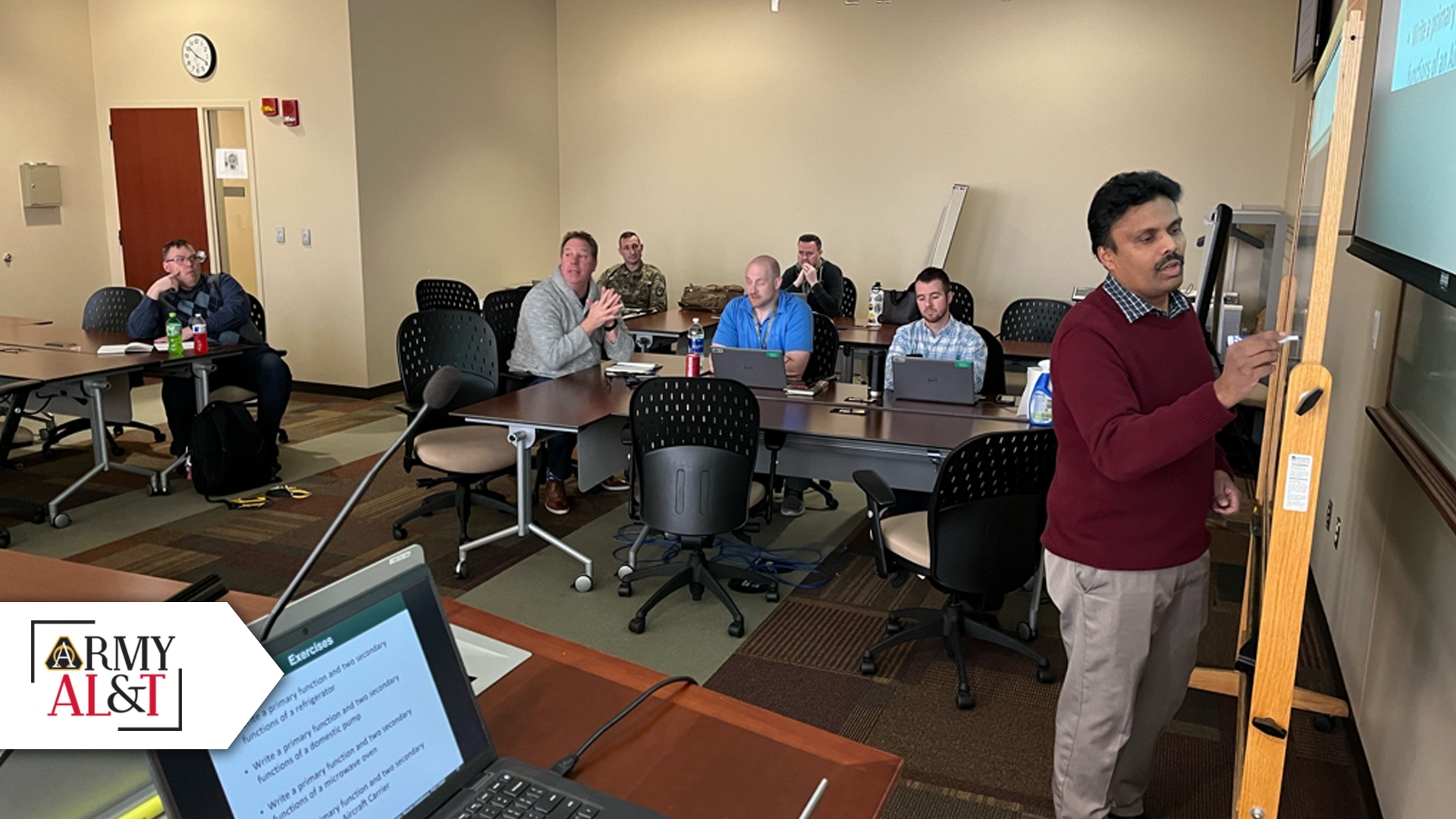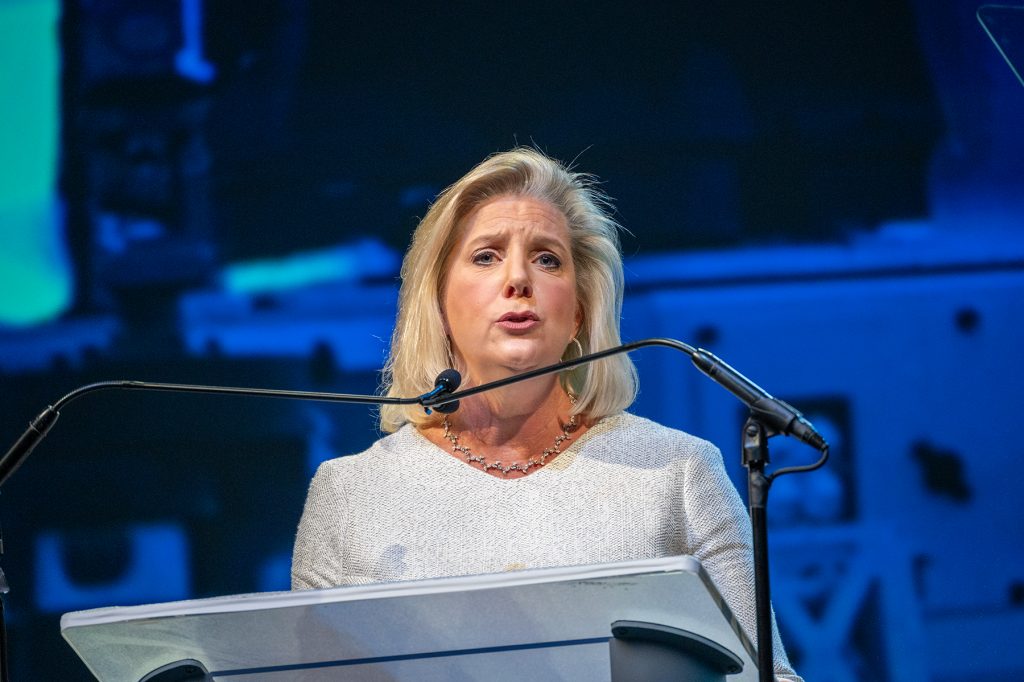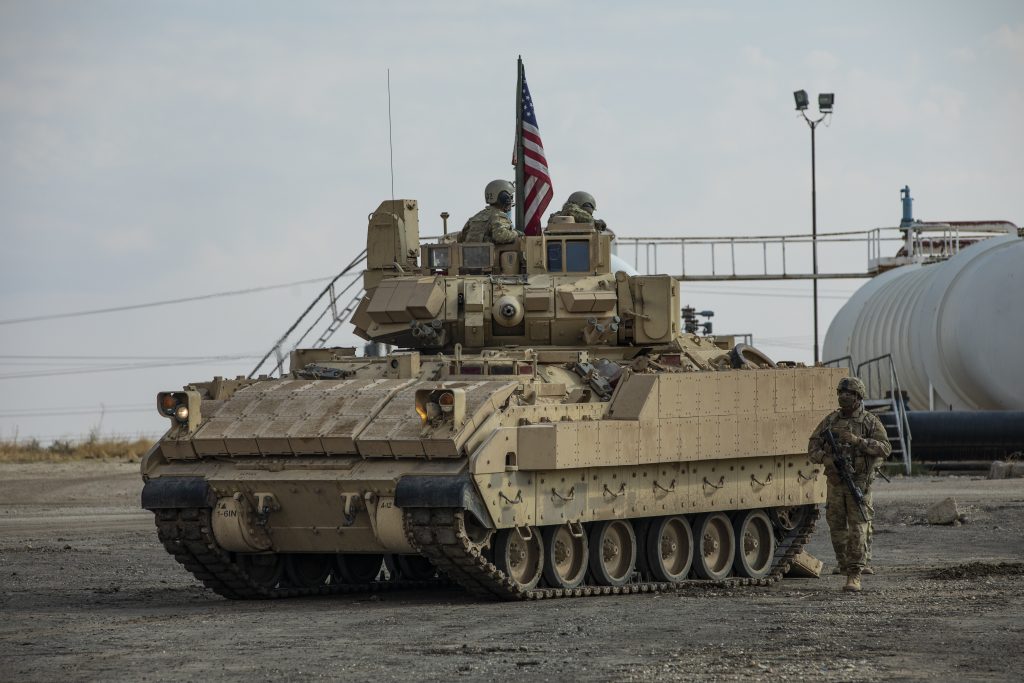
CLASS ACTION: Macam Dattathreya, Ph.D., chief engineer at the DEVCOM Ground Vehicle Systems Center, leads a class on digital engineering for civilians and Soldiers assigned to the NGCV CFT at the Detroit Arsenal. The use of digital engineering is accelerating the development of future combat vehicles, such as the XM30 combat vehicle. (Photo by Dan Heaton, NGCV CFT)
In-house digital engineering course aims to accelerate design and development processes.
by Dan Heaton and Gerald Gomes
A 21st century, data-centric approach being utilized by the U.S. Army is transforming the way future battles will be fought and the way future capabilities will be developed.
A key piece of innovation technology being integrated into Army processes is digital engineering. Digital engineering is the process of digitally designing military equipment, such as future combat vehicles or other military hardware, to be designed and built in a virtual environment where it can be tested, analyzed and can engage with Soldiers before a single piece of iron is bent to build the prototype.
While digital engineering has become the norm in many commercial manufacturing settings, it is still a relatively new concept to the Army, and this knowledge gap has created a need for professional education inside the force. To meet that need, the Next Generation Combat Vehicles Cross-Functional Team (NGCV CFT) created its own, in-house course on digital engineering practices and applications to help accelerate the design and development processes. “One thing that the Army knows how to do well is to identify a challenge and then develop training to build the skill set necessary to meet that challenge,” said Brig. Gen. Geoffrey A. Norman, director of the NGCV CFT, which is utilizing digital engineering to facilitate the development of the XM30 Combat Vehicle and other projects.
The use of digital engineering and other 21st century industrial development tools are in line with the priorities that Secretary of the Army Christine E. Wormuth identified at the 2023 Association of the U.S. Army’s (AUSA) annual meeting. “We must continue to embrace innovation and transformation or risk failing to address future threats,” Wormuth said at the October 2023 AUSA event in Washington. “In close partnership with industry, the Army has pressed ahead and stayed on track to implement our most ambitious modernization effort in 40 years. With the introduction of each new system, we continue to increase our force’s capability to respond to various threats and serve as a credible deterrent to our adversaries.”

EMBRACE INNOVATION: Secretary of the Army Christine E. Wormuth told the AUSA annual convention in October 2023 that the Army “must continue to embrace innovation and transformation or risk failing to address future threats.” (Photo by Christopher Kaufmann, Army Multimedia and Visual Information Division)
WHAT IS DIGITAL ENGINEERING?
The Defense Acquisition University defines digital engineering as “an integrated digital approach that uses authoritative sources of systems’ data and models as a continuum across disciplines to support life cycle activities from concept through disposal.” The beginning of the digital engineering effort for combat vehicles can be traced back to 2021, when the Army placed five companies under contract to develop digital designs of XM30s, a combat vehicle that will replace the M2 Bradley in armored brigade combat teams. The XM30 was previously known as the Optionally Manned Fighting Vehicle.
The digital design process has allowed the Army to save time and cost while developing design solutions for the future armored vehicle.
Five digital designs were analyzed and evaluated by the Army against the requirements detailed in the acquisition process and managed with a product life cycle management (PLM) tool. The PLM tool serves as the product’s authoritative source of truth—a single centralized model to avoid issues of version control that often develops with a document-based approach. The PLM allows the Army to map high-level requirements, from broad-based concepts such as mobility and lethality, to more focused details, such as the tests and evaluations that will prove whether the product meets the capabilities outlined in the Capability Development Document (CDD).
According to DOD’s Digital Engineering Strategy, “The goal [of the authoritative source of truth] is to enable delivery of the right data to the right person for the right use at the right time.”
Norman stressed that imperative as the Army looks to the future of combat vehicles. “We are committed to using the right tools and to building the best teams to drive these new capabilities into our formations,” he said.
Previously, when the Army designed combat vehicles and other major systems, an analog or paper process was used. This document-based approach is expensive and error prone. Costs increase as artifacts become inconsistent and assumptions change faster than the document approval process can support. This created problems with version control and ensuring that all relevant players had access to the most up-to-date information.

TOUCH POINT: Soldiers from 2nd Battalion, 5th Cavalry Regiment participate in a virtual experiment at the Detroit Arsenal in Warren, Michigan. The Soldiers were providing input on possible crew configurations for the XM30 Combat Vehicle. (Photo by Dan Heaton, NGCV CFT)
CRAWL, WALK, RUN
To maximize the use of digital engineering in the XM30 and other development efforts, the Army is taking a “crawl, walk, run” approach to the concept. With the “crawl” step now completed, the Army design team transitioned the XM30 Capabilities Development Document—the document that spells out in detail all the requirements that the vehicle must be able to achieve—into a PLM tool controlled by a single repository.
In the “walk” step, the Army project managers continue to maintain the CDD within the PLM and to map capabilities to performance specifications (P-Specs) to support the request for proposal (RFP) process.
Finally, in the “run” step, which is now ongoing, the Army has generated the CDD within the PLM tool and continues to leverage workflows to refine capabilities and ultimately manage the entire approval process.
“The process allows everyone who is working on the XM30 project to be able to utilize the same digital data, to be able to take the design steps necessary to ensure we are delivering the best vehicle to our Soldiers,” said Lt. Col. J. Michael Eisenlohr, XM30 requirements lead for NGCV CFT. “Since we have engineers and designers in multiple places working on this program, when we make a change in the digital environment, everyone can see that in real time. The efficiencies this creates in time and material costs are significant.”
TEAM TRAINING APPROACH
To facilitate the use of digital engineering and maximize its impact on the combat vehicle development process, the NGCV CFT recently created and conducted a local informal, weeklong overview course on the topic, for Soldiers and civilians. The course began with developing a greater understanding of the Army’s current and future acquisition process and then went more in-depth regarding how to develop accurate requirements to enable model-based requirements. By the end, participants understood that model-based acquisition is built off an authoritative source of truth, a single centrally maintained model that is managed throughout a program’s life cycle.
To assist Army engineers and technicians in closing the knowledge gap on the latest advancements in digital engineering, the NGCV CFT used an on-staff contractor, Gerald Gomes, from within the CFT to design the course. Gomes leveraged his extensive experience working in a digital ecosystem. Before working for NGCV CFT, he spent more than 20 years working as an engineer in the automotive industry. Gomes’ goal for the class was to focus on “institutionalized success,” which is a concept that creates a workflow to yield consistent results from one program to the next, even when a new team is in place. Gomes’ experience in the auto industry is a direct dividend of the Army’s decision to locate the NGCV CFT at the Detroit Arsenal, Michigan, right down the street from the General Motors Technical Center and a stone’s throw away from engineering centers for virtually every international automaker in the world. The primary instructor for the course was Macam Dattathreya, Ph.D., chief engineer at the U.S. Army Combat Capabilities Development Command’s Ground Vehicle Systems Center, which is co-located at the Detroit Arsenal with the NGCV CFT.
The first iteration of the model-based requirements digital engineering course was held at the Detroit Arsenal in February 2024 and brought together about two dozen personnel for the instruction. The course focused on the following concepts:
- Model-based acquisition.
- Model-based requirements.
- Modeling a functional architecture.
- Use cases and use case diagrams.
“Model Based Acquisition is the technical approach to acquisition that uses models and other digital artifacts as the primary means of information exchange, rather than document-based information exchange,” according to the model-based acquisition standards published by the Object Management Group, a professional industry forum.
These models are intended to improve the request for proposal process through increased collaboration in their development and streamlined communication of changes and decisions within the Army and externally to our industry partners. Clearly articulated product requirements significantly reduce the waste of the communication loop associated with a document-based information exchange and allows product development teams a more focused effort around meeting the goals of the RFP.
Model-based requirements can be represented in several ways, but in the case of the NGCV CFT training, the focus was first on the “what” of a good requirement, which was followed by review of how various computer tools can be used to manage these requirements. It is important to note that requirements exist to outline the product’s needs in a clear and concise manner from the users’ perspective. Once these models are created in a digital engineering ecosystem, they afford traceability to downstream teams, and systems continue to work from the authoritative source of truth. This means that if changes are made upstream, then predefined workflows will roll those changes down to affected areas in the model.
Modeling a functional architecture is an important step in digital engineering because it identifies and leverages the product’s primary and secondary functions, and the associated interactions, to demonstrate how they support the system’s mission. This step forces the team to think in greater detail regarding functions vs. preconceived solutions. This opens the door to innovations that wouldn’t have necessarily been considered had the team never taken the step to distill the system down to clear primary, secondary and sometimes tertiary functions.
The use case step is utilized to create a clear picture of how a singular function in the system is used by its operators and the interactions they have with each step in using the product or system. The use case diagrams are utilized to ensure that each stakeholder understands what the system does.
The course allowed the students to test their knowledge via several unique examples and highlighted how different viewpoints can affect the overall solution.

REPLACEMENT NEEDED: The XM30 will replace the M2 Bradley Fighting Vehicle. (Photo by Spc. Jensen Guillory, Combined Joint Task Force – Operation Inherent Resolve)
FUTURE VEHICLE DEVELOPMENT
Now that the first digital engineering overview course has been completed, the cross-functional team will keep that course in its kit for potential use as new personnel are assigned to the XM30 or other projects. NGCV CFT will update and offer the model-based requirements digital engineering course in the future, as the need arises.
“We are maximizing the best, most modern tools available to us to ensure that the vehicle that we deliver will be the best, most capable combat vehicle on the battlefield of tomorrow,” Eisenlohr said.
CONCLUSION
In 2023, the Army awarded contracts to two vendors to create new digital designs and to build physical prototypes of the XM30. Those designs and prototypes will then be tested by Soldiers and evaluated by Army engineers and other specialists before a final design for the vehicle is ultimately selected. The XM30 is scheduled to be first unit issued by the end of 2029.
For more information, contact Dan Heaton at usarmy.detroit.devcom-gvsc.mbx.ngcv-cft@army.mil.
DAN HEATON is the director of communications for the Next Generation Combat Vehicle Cross-Functional Team (NGCV CFT), based at the Detroit Arsenal. Heaton became an Army civilian and joined the NGCV CFT in 2020 after a long career in the media and local government service. Heaton also serves as a senior master sergeant public affairs specialist in the Michigan Air National Guard’s 127th Wing and has more than 30 years of military service. He holds an M.S. in marketing from Walsh College and a B.A. in human resource management from Spring Arbor University.
GERALD GOMES is the chief systems engineer contracted to support the NGCV CFT through the Army Futures Command. He holds an M.S. in manufacturing engineering from the University of Michigan and a B.S. in mechanical engineering from Kettering University. His professional career includes 20 years at original equipment manufacturers in the auto industry in numerous leadership roles, including five years as an advanced engineering manager at a Tier 1 auto supplier, and more than three years in the defense industry.







